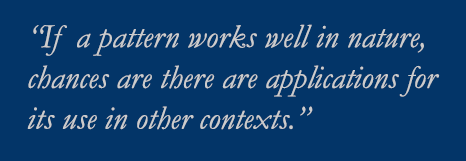Patterns exist in nature, in ideas and thought, as well as in human affairs. The trick is to recognize these patterns and make sense of them. Nature’s abundance, though seemingly chaotic, conforms to certain laws. It has long been recognized, for example, that Fibonacci sequences can be seen in the pattern arrangement of flowers and plants. Fractal patterns show up in snowflakes, river networks, and blood-vessel branching. Tessellation-like layering is displayed in snake and fish scales as well as in wasp and hornet nests.
Once a pattern is detected, certain questions can help make sense of things: Why is this pattern being utilized? What purpose does it serve? What are the advantages and disadvantages of its design? How can this pattern shed light on any current challenges or problems we face in everyday life?
Will a fractal pattern help us understand the relationship between people? Will a Fibonacci sequence help lead us to a new solution pertaining to work or life? If a pattern works well in nature, chances are there are applications for its use in other contexts. “Thought as design” can help conceptualize ideas and can be usefully employed as a technique to solve everyday problems.
Artists and architects have long sought out the relationship between designs and patterns  and the problems faced by those living within a certain time. Frank Lloyd Wright, for example, has written:
and the problems faced by those living within a certain time. Frank Lloyd Wright, for example, has written:
Standing here as I do again today, I am really an emissary of the ground, preaching the salt and savor of a new and a fresh life. I urge you to be a little less self-consciously educated and conservative, to be a little more liberally reasonable, and all of you–every architect included–should–daily for seven minutes if possible–do a little more serious and a little deeper thinking on the subject of what constitutes organic character in economics, in statesmanship, in architecture, yes, and why not in salesmanship? True architecture my noble lords, ladies and gentlemen…is poetry. A good building is the greatest of poems when it is organic architecture. The fact that the building faces and is reality and serves while it releases life, makes daily life better worth living and makes all the necessities happier because of useful living in it, makes the building none the less poetry, but more truly so. Every great architect is—necessarily—a great poet. He must be a great original interpreter of his time, his day, his age.[1]
This linking of the specific to the general would not at first glance be apparent: it’s not often one thinks of a well-designed building as a poetic interpretation of a particular time and place. Along these lines Arnold Hauser has written:
The purpose of the work of art constantly wavers between these two points of view, between an immanent being, detached from all reality beyond the work itself, and a function determined by life, society and practical necessity. From the standpoint of the direct aesthetic experience, autonomy and self-sufficiency appear to be the essence of the work of art, for only by cutting itself off from reality and putting itself completely in the place of reality, only by forming a total, self-contained cosmos, is it able to produce a perfect illusion. But this illusion is in no way the whole content of art and often has no share in the effect it produces. The greatest works of art forgo the deceptive illusionism of a self-contained aesthetic world and point beyond themselves. They stand in an immediate relationship to the great problems of their age and are always searching for an answer to the questions: How can a purpose be gained from human life? and: How can we participate in this purpose?[2]
Both Wright and Hauser recognized how design and pattern can create meaning while simultaneously improving life. If well-designed architecture “serves while it releases life,” there’s no reason why this same ideal cannot be applied to other contexts as well.
Additionally, both Wright and Hauser recognized the importance of the relationship between an architectural or artistic design and the urgencies and exigencies of a particular time and place. The best creative works are not self-contained. They exist for a purpose. They open a link between a creative vision and the society in which they were created. Ideally one’s work should strive to bridge this gap as well. If it does, there may be unseen benefits to one’s day to day toil, and, over a period of years, one may come to view one’s work not as a series of random, seemingly disconnected events, but as a pattern with its own internal coherence, unity, and logic.
[1] Frank Lloyd Wright, The Future of Architecture, pg. 262 (Horizon Press 1953)
[2] Arnold Hauser, The Social History of Art: Naturalism, Impressionism, The Film Age, pg. 23 (Volume 4 Vintage Books 1951)




